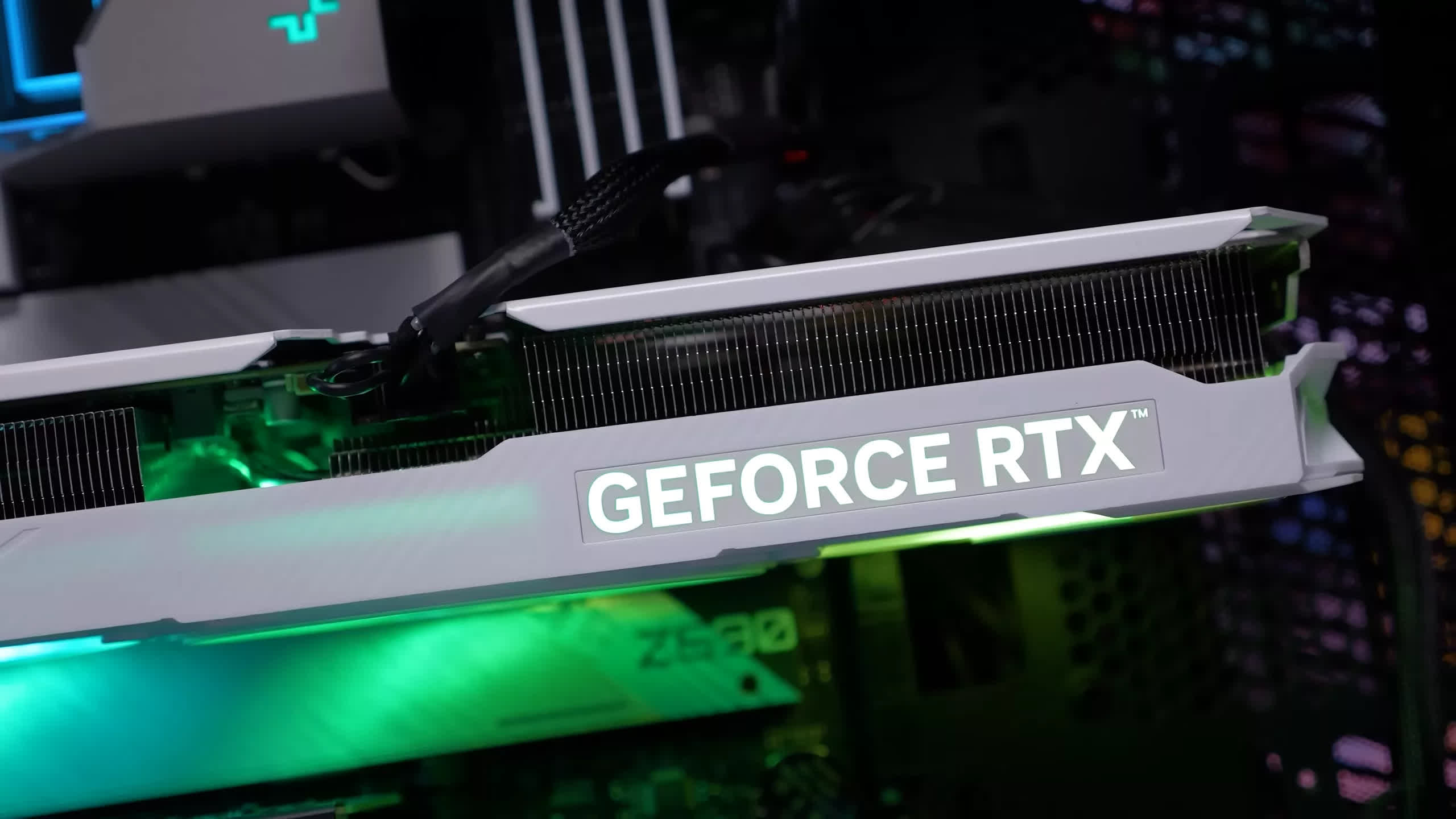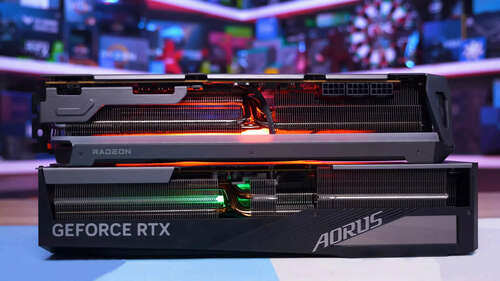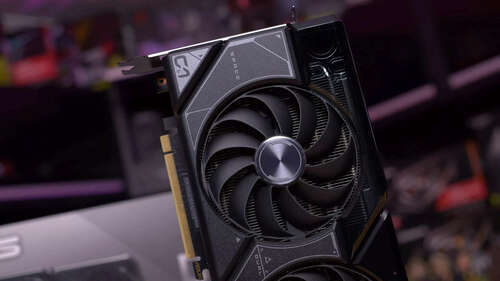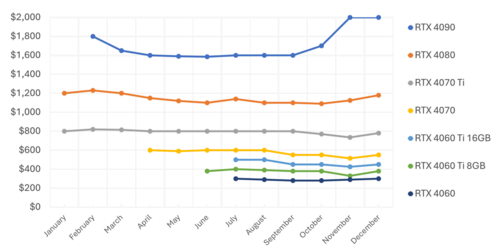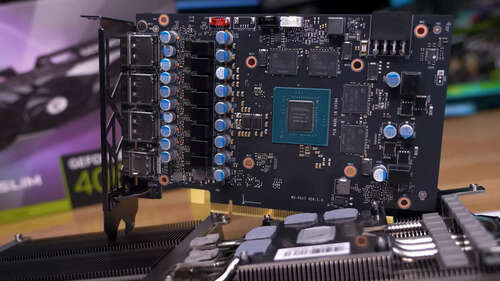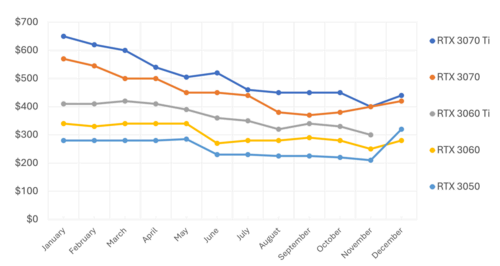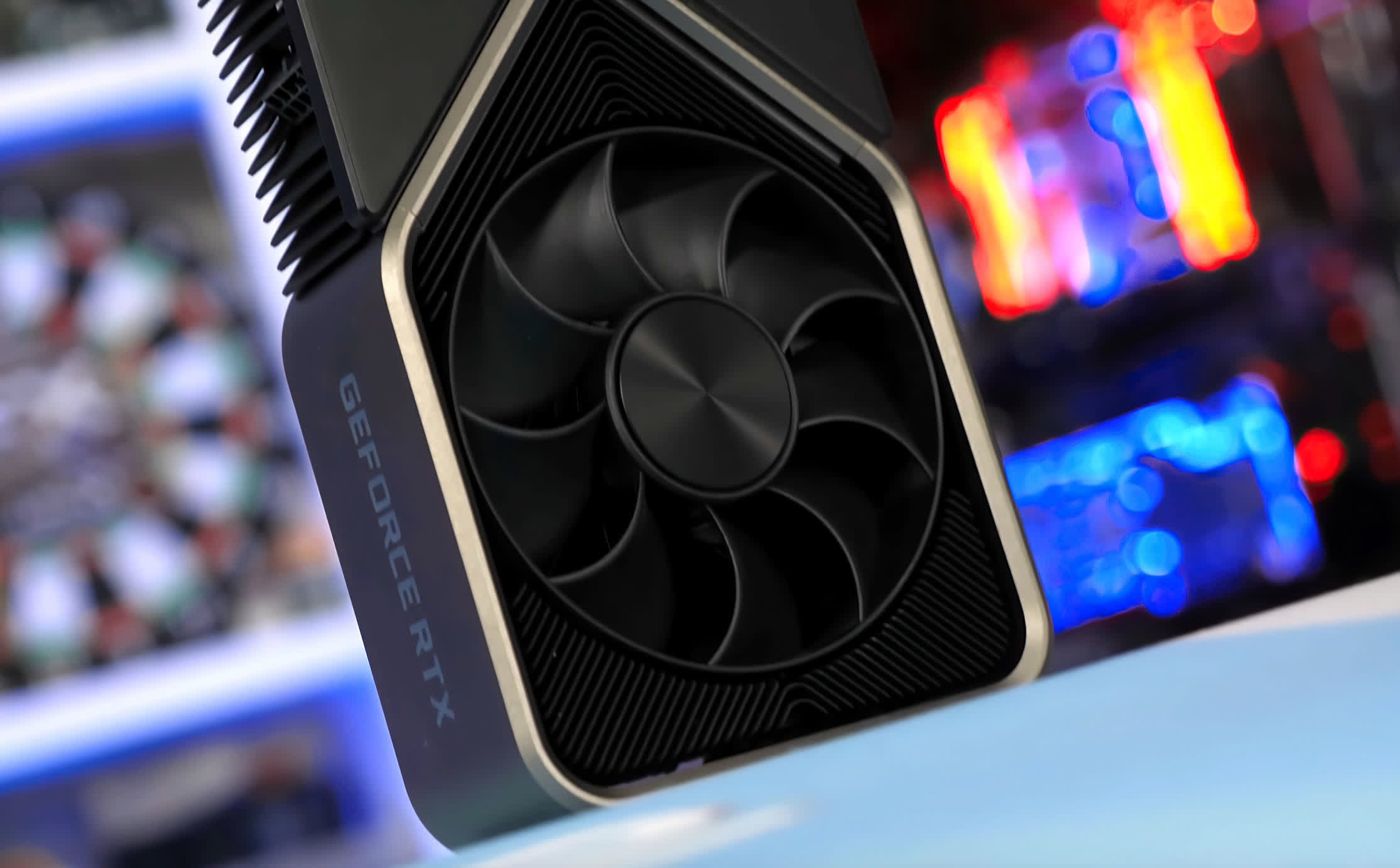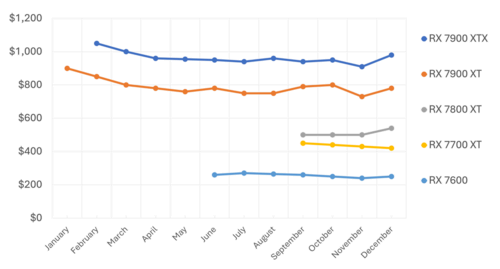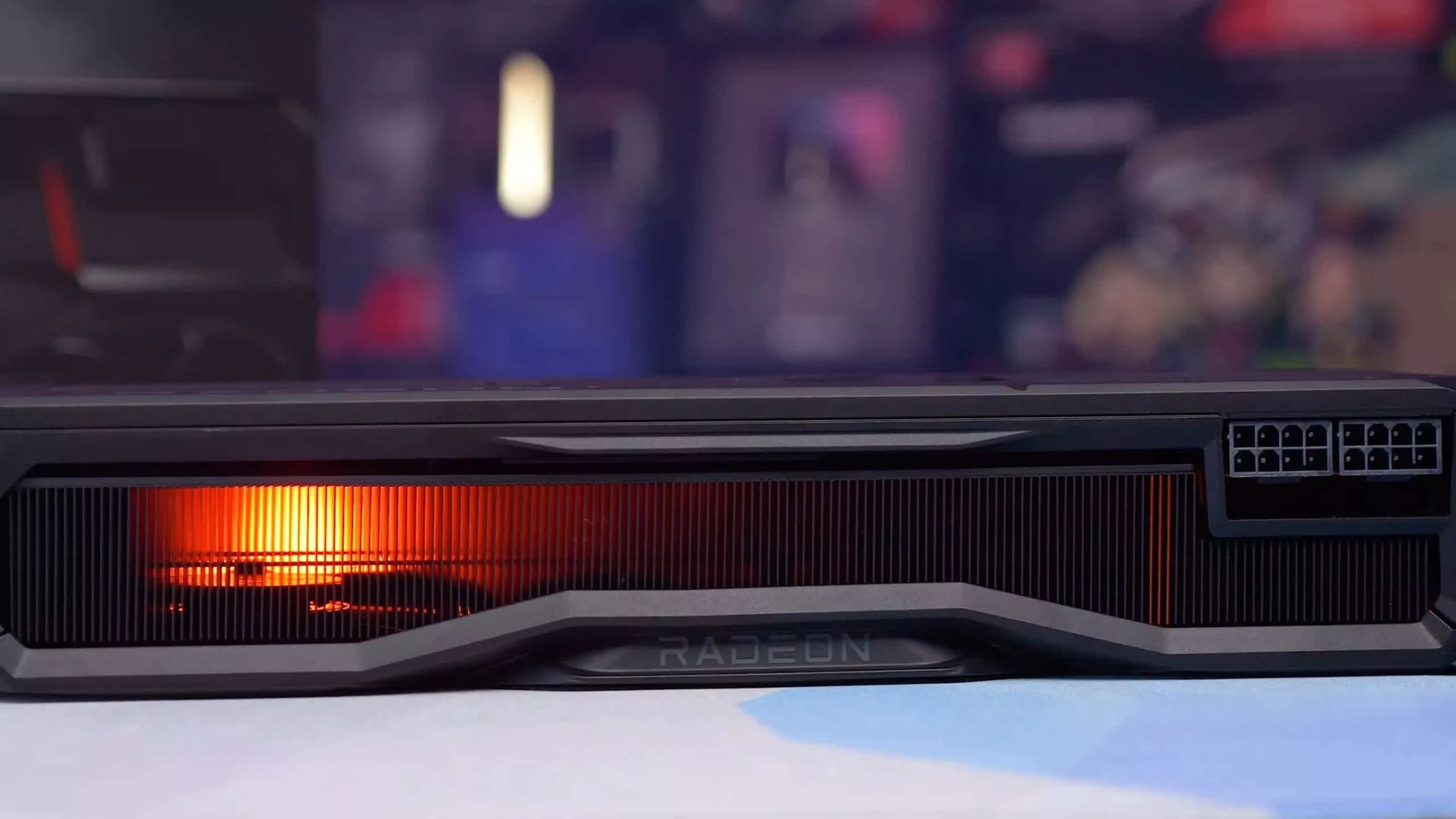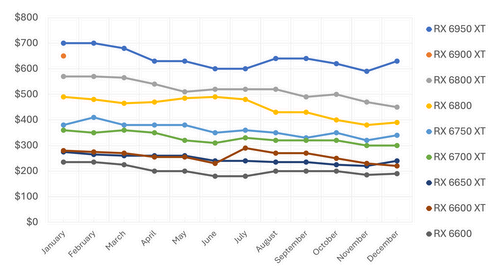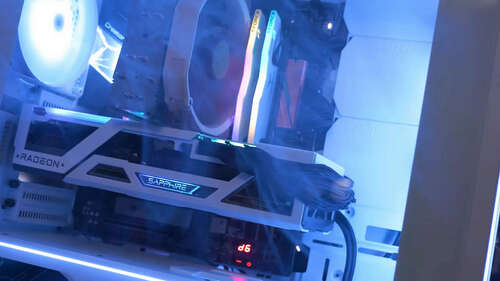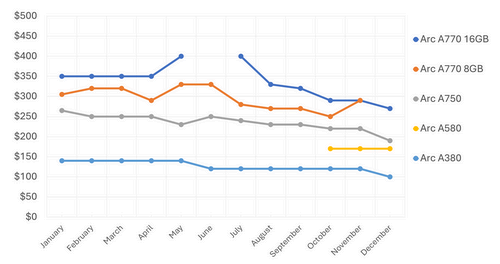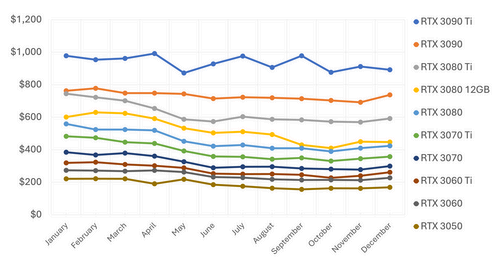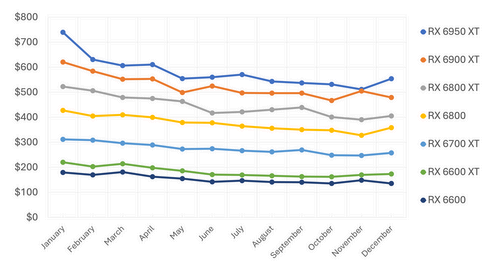Welcome back for our monthly GPU pricing update, the last one of the year. In today’s article we have some chat about upcoming GPUs, historical pricing information and price trends for the last 12 months, and some recommendations about whether you should buy a graphics card now or wait.
Buying or Waiting?
Straight to that last point, if you are thinking about buying a new graphics card around Christmas – for example, if you get a bit of cash for Christmas and want to put that towards a new GPU upgrade – the most sensible decision at this point would be to wait until mid-January. This is due to the impending launch of Nvidia’s RTX Super series graphics cards. We discussed these a bit in the last update, but we now have some additional clarity around the launch.
We’re fairly confident that Nvidia will unveil refreshed RTX 40 graphics cards at CES 2024, scheduled for January 8th. This has been a likely situation for some time now, so it wouldn’t make much sense to purchase a graphics card before learning what the Super series offers. Additional rumors suggest that the cards will be unveiled and also put on sale in January, so it won’t be long until you can actually buy them – if that information proves right, of course.
We often get asked whether it makes sense to buy existing GPUs right before the release of new models, or to wait for the new models to be revealed. The thinking is that occasionally the old models will get discounted right before new models hit the market, and then potentially disappear by the time the new cards come out. Even worse, the new cards could present worse value than the existing models, or worse value than discounted prices around launch.
However, it’s pretty rare these days to see preemptive discounts ahead of a new product unveiling. As far as we can tell, that certainly is not happening right now. There has been little to no price movement for cards like the RTX 4070 and RTX 4080. We also haven’t seen situations this generation where existing models go up in price after new models get released, so the worst-case scenario is likely to be that the current pricing model remains in place after the Super launch. There appears to be plenty of stock as well, meaning it’s unlikely we’d suddenly see these cards sell out at current prices once we learn about new GPUs.
We think it’s much better to wait so you have all the information in front of you before making a purchase. If the RTX Super series presents better value than current models, you’ll be able to harness one of two situations: either the Super cards will be worth purchasing, giving you a better product than what you can currently buy; or the older models will get discounted, making them worth buying but now at a lower price. And if the Super series is similar in value, you’ll be in a similar situation to right now, except you’ll know exactly where everything stands and you’ll be able to make an informed decision.
The Mid-Range
This also applies if you are considering either a GeForce or Radeon GPU in the mid to upper range. If the RTX 4070 Super is exceptionally good value, for example, this could force AMD to lower the price of the Radeon RX 7800 XT, and they’ve certainly been willing to adjust pricing to match the current market. If you’re considering anything in the $500-plus category, waiting makes the most sense.
For lower-tier buyers, those thinking about the GeForce RTX 4060 or Radeon RX 7600 or RX 6600, for example, it’s very unlikely we will see new Super GPUs in this price category, at least with the initial CES release. So if you’re thinking about buying that type of card, we don’t think it’ll make much difference whether you buy now or in January, so our usual advice about looking for excellent deals still applies.
We’re also not expecting heaps from the GeForce RTX 40 Super series. These are not going to be significantly improved products akin to an all-new GPU generation. Rumors suggest a minor upgrade from the RTX 4080 to RTX 4080 Super, a modest improvement for the RTX 4070 Ti to the 4070 Ti Super headlined by an increase to 16GB of VRAM, and a modest improvement for the RTX 4070 to RTX 4070 Super as well. Performance gains no higher than 20%, probably closer to 10% or less, is what you should be expecting.
Unfortunately, for the rest of the GPU market, there are two pieces of not-so-good news at the moment. RTX 4090 pricing continues to be impacted by export restrictions to China, which has seen many AIBs and distributors trying to get 4090s into China before the restrictions take effect. This has caused a vacuum of supply in other regions, leading to inflated pricing. Right now, you can expect to pay around $2,000 for an RTX 4090, much higher than its launch MSRP and much harder to justify despite its excellent performance.
We’re also seeing inflated pricing for the Radeon RX 7800 XT to the point where it’s not worth buying. This card should have an MSRP of $500, where the cheapest models should be positioned. However, currently, the cheapest cards are at $540. This diminishes the value proposition of the 7800 XT because you can grab an RTX 4070 right now for just $550, and there’s the impending launch of Super GPUs as well.
In our 45-game benchmark from a few months ago, the 7800 XT was just 5% faster across a mixture of rasterized and ray traced games at 1440p. Now, if the 7800 XT was at its MSRP of $500, that would make it 5% faster and 9% cheaper compared to the 4070 priced at $550, a reasonable though not spectacular deal. When it’s 5% faster at about the same price, it’s difficult to justify buying the Radeon GPU given Nvidia’s stronger feature set. AMD really needs to get the 7800 XT back down near $500, instead of allowing prices to creep up, making the card irrelevant in the current market.
Nvidia RTX 4000 GPU Price Trends
| MSRP | Lowest Price Oct | Lowest Price Nov | Lowest Price Dec | Current Price Inflation | Increase Nov to Dec | |
|---|---|---|---|---|---|---|
| GeForce RTX 4090 | $1,600 | $1,700 | $2,000 | $2,000 | 25% | 0% |
| GeForce RTX 4080 | $1,200 | $1,090 | $1,125 | $1,180 | -2% | 5% |
| GeForce RTX 4070 Ti | $800 | $770 | $735 | $780 | -3% | 6% |
| GeForce RTX 4070 | $600 | $550 | $515 | $550 | -8% | 7% |
| GeForce RTX 4060 Ti 16GB | $500 | $450 | $425 | $450 | -10% | 6% |
| GeForce RTX 4060 Ti 8GB | $400 | $380 | $330 | $380 | -5% | 15% |
| GeForce RTX 4060 | $400 | $280 | $290 | $300 | 0% | 3% |
| Average | 0% | 6% |
When assessing the entire GPU market in 2023 from January to December, there has been little price movement for Nvidia’s RTX 40 series cards, which launched at the end of 2022. We aren’t in the cryptocurrency days anymore where pricing was highly volatile; the pricing that Nvidia set at launch has been held pretty consistently across 2023. The exception being the RTX 4090, of course.
At best, the GeForce RTX 4080 got as much as 10 percent cheaper, excluding quick flash sales we didn’t record, and right now it’s just $20 less than its January price. The RTX 4070 Ti was $800 up until September, with its lowest price of $735 leading to an 8% discount versus MSRP. The RTX 4070 is currently a $550 GPU, with its lowest price last month providing a 14% discount compared to launch. The 4060 Ti 16GB has also dropped by $50, at one point being available at a 15% discount, while the 4060 Ti 8GB was as much as 18% off. Meanwhile, the RTX 4060 has been consistently between $280 and $300.
This is a very normal market, and while some people would love to return to the days of more attractively priced graphics cards – or a return to bigger drops month on month – that just isn’t the reality for current generation Nvidia cards. At best, we’ve seen modest price adjustments to respond to new Radeon GPUs or particularly poor launches.
Nvidia RTX 30 Series GPU Price Trends
Surprisingly, cards from the RTX 3070 Ti through to RTX 3050 have remained in stock for pretty much the entire year. In fact, just now in December, we are starting to see the final RTX 3060 Ti and RTX 3050 models being sold. While pricing has risen for some models over the last month and a bit, it’s these older cards where there has been a more consistent downward pricing trend, as Nvidia launches new cards and becomes more eager to move these older models.
| MSRP | Lowest Price Oct | Lowest Price Nov | Lowest Price Dec | Current Price Inflation | Increase Nov to Dec | |
|---|---|---|---|---|---|---|
| GeForce RTX 3090 Ti | $2,000 | No stock | No stock | No stock | n/a | |
| GeForce RTX 3090 | $1,500 | No stock | No stock | No stock | n/a | |
| GeForce RTX 3080 Ti | $1,200 | No stock | No stock | No stock | n/a | |
| GeForce RTX 3080 12GB | n/a | No stock | No stock | No stock | n/a | |
| GeForce RTX 3080 10GB | $700 | No stock | No stock | No stock | n/a | |
| GeForce RTX 3070 Ti | $600 | $450 | $400 | $440 | -27% | 10% |
| GeForce RTX 3070 | $500 | $380 | $400 | $420 | -16% | 5% |
| GeForce RTX 3060 Ti | $400 | $330 | $300 | No stock | -25% | |
| GeForce RTX 3060 | $330 | $280 | $250 | $280 | -15% | 12% |
| GeForce RTX 3050 | $250 | $220 | $210 | $220 | -12% | 5% |
| Average | -19% | 6% |
The RTX 3070 Ti and RTX 3070 have dropped in price by as much as 38% and 35% respectively over the course of the year. The RTX 3060 Ti ended up 29% cheaper than its peak in March, and the RTX 3060 became notably cheaper in June when the RTX 4060 was announced. It ended up with as much as a 26% discount across 2023. The RTX 3050 is pretty much out of stock now but also fell in price considerably in June, with a similar price drop as the RTX 3060 from worst to best this year.
Despite this, most of these adjustments have simply been in response to new RTX 40 series models. For example, up until April or May, most of these cards were actually being sold above their MSRP: the 3070 started the year at $570 and the RTX 3050 at $280. The best case we saw was as much as a 25% discount compared to the MSRP for these cards, although in the case of a 3050, for example, Nvidia only ever offered this model for 16% below MSRP.
AMD Radeon 7000 GPU Price Trends
On the AMD side with their current generation models, there has been a bit more price fluctuation than for Nvidia, especially for their two less favorably received products, the Radeon RX 7900 XT and RX 7700 XT. But when AMD got the pricing right and there was more interest in the model at launch, those GPUs have remained much more consistent in pricing.
| MSRP | Lowest Price Oct | Lowest Price Nov | Lowest Price Dec | Current Price Inflation | Increase Nov to Dec | |
|---|---|---|---|---|---|---|
| Radeon RX 7900 XTX | $1,000 | $950 | $910 | $980 | -2% | 8% |
| Radeon RX 7900 XT | $900 | $800 | $730 | $780 | -13% | 7% |
| Radeon RX 7800 XT | $350 | $500 | $500 | $540 | 8% | 8% |
| Radeon RX 7700 XT | $320 | $440 | $430 | $420 | -7% | -2% |
| Radeon RX 7600 | $270 | $250 | $240 | $250 | -7% | 4% |
| Average | -4% | 5% |
The Radeon RX 7900 XTX debuted above its MSRP and was hard to come by for a few months. It has since dropped in price by as much as 13 percent, though right now you’ll only see a $20 discount compared to the MSRP. The 7900 XT was the biggest mover, quickly falling below $900 to offer up to a 19% price cut, although right now and in several prior months, this GPU has been more like $780, which is a 13% price correction.
The 7800 XT, as mentioned, has never fallen below $500 and now sits at $550, an unfortunate price inflation. Meanwhile, the 7700 XT has gradually fallen over the last few months to end the year with a 7% discount. The RX 7600 has fallen by as much as 11 percent. This gives us a good insight into how much price flexibility there is at the moment and what we can expect as this new normal continues into 2024.
AMD Radeon 6000 GPU Price Trends
| MSRP | Lowest Price Oct | Lowest Price Nov | Lowest Price Dec | Current Price Inflation | Price Increase Nov to Dec | |
|---|---|---|---|---|---|---|
| Radeon 6950 XT | $1,100 | $620 | $590 | $630 | -67% | -39% |
| Radeon 6900 XT | $1,000 | No stock | No stock | No stock | n/a | |
| Radeon 6800 XT | $650 | $500 | $470 | $450 | -31% | -4% |
| Radeon 6800 | $580 | $400 | $380 | $390 | -33% | 3% |
| Radeon 6750 XT | $550 | $350 | $320 | $340 | -38% | 6% |
| Radeon 6700 XT | $480 | $320 | $300 | $300 | -38% | 0% |
| Radeon 6650 XT | $400 | $225 | $220 | $240 | -40% | 9% |
| Radeon 6600 XT | $380 | $250 | $230 | $220 | -42% | -4% |
| Radeon 6600 | $330 | $200 | $185 | $190 | -42% | 3% |
| Radeon 6500 XT | $200 | $140 | $170 | $140 | -30% | -18% |
| Radeon 6400 | $160 | $135 | $130 | $120 | -25% | -8% |
| Average | -39% | -5% |
For AMD’s previous generation models, some of these cards have been surprisingly consistent in pricing, with the bulk of price cuts happening prior to 12 months ago. In January, for example, models like the RX 6950 XT, RX 6700 XT, and RX 6600 were all available well below their launch MSRP.
Across the year, the RX 6950 XT saw as much as a 16% price drop, while the 6900 XT dropped out of stock in January. The RX 6800 XT is the cheapest it’s ever been, 21% less than what it went for at the start of the year. The RX 6800 fell by as much as 22%, with the bulk of this drop occurring around the launch of the 7800 XT.
In the mid-range, the Radeon 6750 XT has fluctuated a bit but still fallen by as much as 22%, though this shrinks to 11% comparing December pricing to January. The 6700 XT has seen a 17% drop across the year. For the 6650 XT, there has been as much as a 16% price drop, while the 6600 XT has fallen by 21%, although there was a noticeable price hike in the middle of the year for this card. The best case for the Radeon RX 6600 has been a 23% price drop, although currently, we’re looking at a 19% discount compared to January.
This level of discount has generally pushed each card to the tier below across 12 months. In January, you would have paid $380 for a 6750 XT; nowadays, that amount gets you an RX 6800. Similarly, the RX 6600 started at $235; right now, that gets you an RX 6650 XT. That seems quite reasonable even if the percentage drops haven’t been as significant as for the 30 series.
Intel Arc GPU Price Trends
| MSRP | Lowest Price Oct | Lowest Price Nov | Lowest Price Dec | Current Price Inflation | Increase Nov to Dec | |
|---|---|---|---|---|---|---|
| Intel Arc A770 16GB | $350 | $290 | $290 | $270 | -23% | 0% |
| Intel Arc A770 8GB | $320 | $250 | $290 | No stock | -9% | 0% |
| Intel Arc A750 | $290 | $220 | $220 | $190 | -34% | 0% |
| Intel Arc A580 | $290 | $170 | $170 | $170 | -6% | |
| Intel Arc A380 | $140 | $120 | $120 | $100 | -29% | -17% |
| Average | -20% | -4% |
Intel has also been keeping up with GPU pricing trends with their Arc products, which, along with continued driver development, makes Arc more and more appealing as time goes on. The A770 16GB has received a 23% price drop over the course of the year, while the 8GB model is now out of stock.
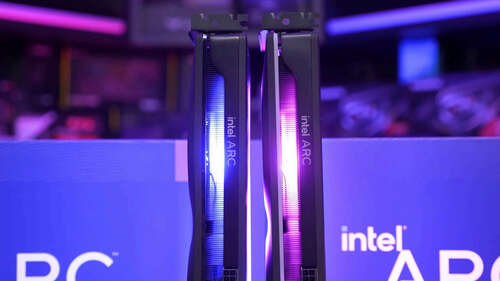
Pricing has been even more aggressive for the A750, a 28% reduction comparing December to January with the latest sales bringing it down to $190. The A580 has been holding steady, while the A380 has been dropping in occasional increments.
Used Graphics Cards Pricing
Used pricing has followed similar trends to the new market for generation-old cards. We’ve seen a bit of an uptick in December for used pricing, although for Nvidia GPUs across the year, we were still seeing around a 20 to 30 percent price drop for most cards, best case. Some examples are the 3080 Ti seeing up to a 26% price drop, a 28% drop for the RTX 3070, and a 22% drop for the RTX 3060.
| MSRP | Newegg Lowest Price Oct | eBay Used Price Nov | eBay Used Price Dec | Used Price Hike Nov to Dec | Discount Used vs New | |
|---|---|---|---|---|---|---|
| GeForce RTX 3090 Ti | $2,000 | No stock | $978 | $891 | -9% | |
| GeForce RTX 3090 | $1,500 | No stock | $713 | $737 | 3% | |
| GeForce RTX 3080 Ti | $1,200 | No stock | $583 | $591 | 1% | |
| GeForce RTX 3080 12GB | n/a | No stock | $429 | $446 | 4% | |
| GeForce RTX 3080 10GB | $700 | No stock | $409 | $423 | 3% | |
| GeForce RTX 3070 Ti | $600 | $450 | $349 | $357 | 2% | -11% |
| GeForce RTX 3070 | $500 | $380 | $285 | $298 | 5% | -26% |
| GeForce RTX 3060 Ti | $400 | $330 | $245 | $261 | 7% | -13% |
| GeForce RTX 3060 | $330 | $280 | $214 | $226 | 6% | -10% |
| GeForce RTX 3050 | $250 | $220 | $156 | $168 | 8% | -20% |
| Average | 3% | -16% |
| MSRP | Newegg Lowest Price Oct | eBay Used Price Nov | eBay Used Price Dec | Used Price Hike Nov to Dec | Discount Used vs New | |
|---|---|---|---|---|---|---|
| Radeon 6950 XT | $1,100 | $532 | $538 | $554 | 3% | -6% |
| Radeon 6900 XT | $1,000 | $468 | $497 | $479 | -4% | |
| Radeon 6800 XT | $650 | $402 | $440 | $405 | -8% | -14% |
| Radeon 6800 | $580 | $349 | $351 | $359 | 2% | -6% |
| Radeon 6750 XT | $550 | $306 | $301 | $258 | ||
| Radeon 6700 XT | $480 | $249 | $270 | $173 | -36% | -42% |
| Radeon 6650 XT | $400 | $225 | $188 | $136 | -28% | -38% |
| Radeon 6600 XT | $380 | $250 | $164 | $173 | 5% | -25% |
| Radeon 6600 | $330 | $200 | $141 | $136 | -4% | -26% |
| Radeon 6500 XT | $200 | $140 | $82 | $118 | ||
| Radeon 6400 | $160 | |||||
| Average | -8% | -22% |
A similar story for used AMD GPUs, which have largely fallen in price by that 20 to 30 percent range across the year. The RX 6900 XT has dropped by 25 percent, the 6700 XT by 21 percent, and the RX 6600 by 24 percent with pretty steady declines for most models, also with a small uptick in December. The older these cards get, the less they are worth, which makes sense.
| MSRP | eBay Average Price Oct | eBay Average Price Nov | eBay Average Price Dec | Current Price Inflation | Price Increase Nov to Dec | |
|---|---|---|---|---|---|---|
| GeForce RTX 2080 Ti | $1,000 | $302 | $345 | $310 | -69% | -10% |
| GeForce RTX 2080 Super | $700 | $221 | $233 | $229 | -67% | -2% |
| GeForce RTX 2080 | $700 | $196 | $224 | $190 | -73% | -15% |
| GeForce RTX 2070 Super | $500 | $178 | $184 | $190 | -62% | 3% |
| GeForce RTX 2070 | $500 | $154 | $167 | $170 | -66% | 2% |
| GeForce RTX 2060 Super | $400 | $149 | $167 | $156 | -61% | -6% |
| GeForce RTX 2060 | $350 | $130 | $133 | $136 | -61% | 2% |
| Average | -66% | -4% |
| MSRP | eBay Average Price Oct | eBay Average Price Nov | eBay Average Price Dec | Current Price Inflation | Price Increase Nov to Dec | |
|---|---|---|---|---|---|---|
| GeForce GTX 1660 Ti | $280 | $102 | $92 | $110 | -61% | 20% |
| GeForce GTX 1660 Super | $230 | $92 | $91 | $99 | -57% | 8% |
| GeForce GTX 1660 | $220 | $80 | $85 | $82 | -63% | -4% |
| GeForce GTX 1650 Super | $160 | $82 | $80 | $83 | -48% | 4% |
| GeForce GTX 1650 | $150 | $79 | $82 | $79 | -47% | -4% |
| Average | -55% | 5% |
| MSRP | eBay Average Price Oct | eBay Average Price Nov | eBay Average Price Dec | Current Price Inflation | Price Increase Nov to Dec | |
|---|---|---|---|---|---|---|
| Radeon 5700 XT | $400 | $126 | $119 | $138 | -65% | 16% |
| Radeon 5700 | $350 | $114 | $114 | $120 | -66% | 5% |
| Radeon 5600 XT | $280 | $95 | $89 | $106 | -62% | 19% |
| Radeon 5500 XT 8GB | $200 | $83 | $87 | $92 | -54% | 6% |
| Average | -62% | 12% |
For the most part, 2023 has seen the GPU market return to what we’d describe as largely normal conditions. It’s not the “old normal” that many people would like – we could argue for months that current GPU prices are too high; we’ve certainly been doing a lot of that – but as far as price movements are concerned, discounts as new GPUs hit store shelves, it all looks pretty normal. We are now well beyond the time when cryptocurrency was having a significant effect on GPU prices, aside from rare instances, GPUs are at or below their MSRP these days.
The only thing somewhat unusual right now is the continued availability of brand new last-generation models well into this new generation. Both Nvidia and AMD have been more aggressive at dropping old GPU pricing than new GPU pricing in the hopes of pushing those cards out the door, but even that hasn’t been a total success. This is a symptom of a generally slow GPU market, with lower interest and fewer purchases being made than the GPU manufacturers would like, especially given they oversupplied those older models when graphics cards were flying off shelves.
That’s not to say this generation has been a total failure, though, as each GPU launch has seen more sales around that period than in prior months, so launches are leading to increased interest and purchases. There’s also been notable price adjustments as new cards come to market. It’s just not an especially good or interesting GPU generation, and what we’ve seen over 2023 has confirmed that.
